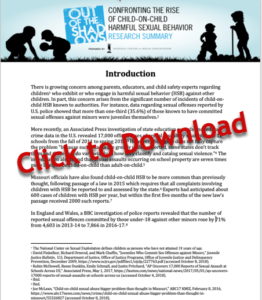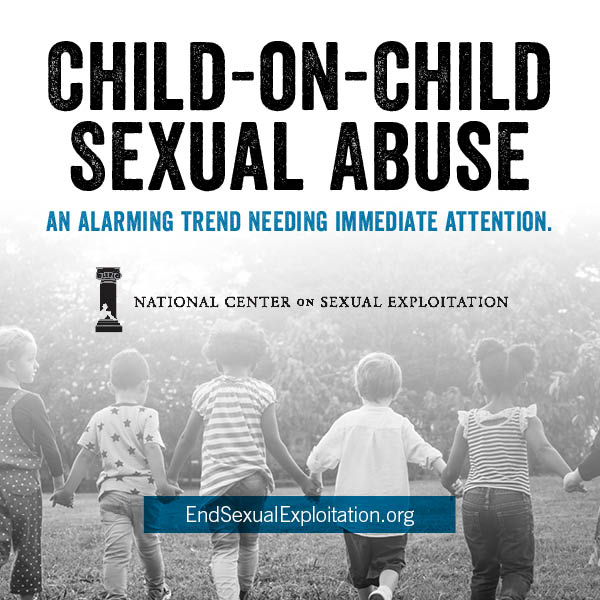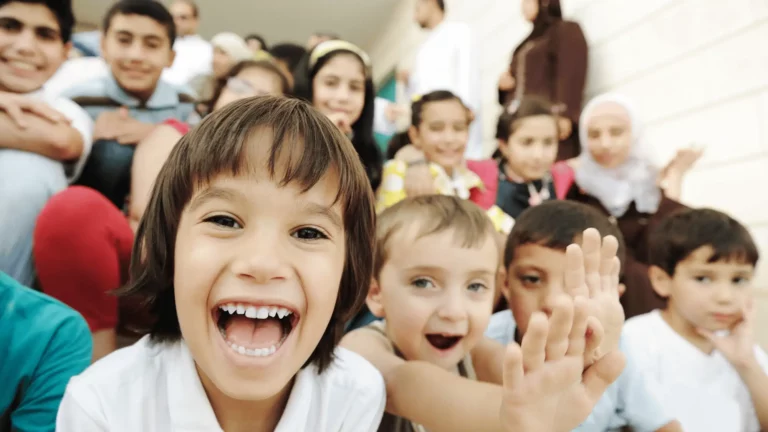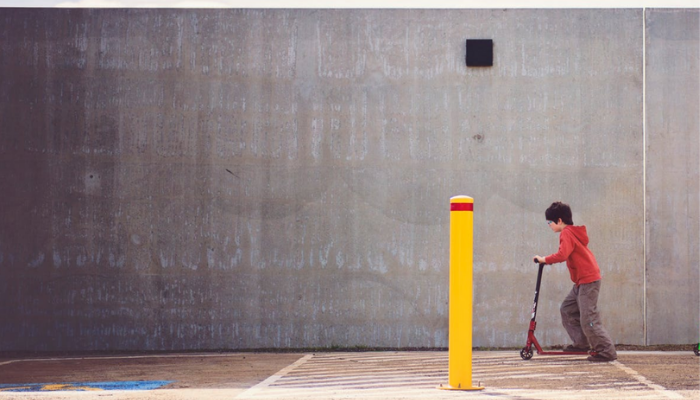 There is growing concern among parents, educators, and child safety experts regarding children[1] who exhibit or who engage in harmful sexual behavior (HSB) against other children. In part, this concern arises from the significant number of incidents of child-on-child HSB known to authorities. For instance, data regarding sexual offenses reported by U.S. police showed that more than one-third (35.6%) of those known to have committed sexual offenses against minors were juveniles themselves.[2]
There is growing concern among parents, educators, and child safety experts regarding children[1] who exhibit or who engage in harmful sexual behavior (HSB) against other children. In part, this concern arises from the significant number of incidents of child-on-child HSB known to authorities. For instance, data regarding sexual offenses reported by U.S. police showed that more than one-third (35.6%) of those known to have committed sexual offenses against minors were juveniles themselves.[2]
More recently, an Associated Press investigation of state education records and federal crime data in the U.S. revealed 17,000 official cases of sexual assault by students in K-12 schools from the fall of 2011 to spring 2015.[3] However, this figure does not fully capture the problem “because such attacks are greatly under-reported, some states don’t track them and those that do vary widely in how they classify and catalog sexual violence.”[4] The investigation also found that sexual assaults occurring on school property are seven times more likely to be child-on-child than adult-on-child.[5]
Missouri officials have also found child-on-child HSB to be more common than previously thought, following passage of a law in 2015 which requires that all complaints involving children with HSB be reported to and assessed by the state.[6] Experts had anticipated about 600 cases of children with HSB per year, but within the first five months of the new law’s passage received 2000 such reports.[7]
In England and Wales, a BBC investigation of police reports revealed that the number of reported sexual offences committed by those under-18 against other minors rose by 71% from 4,603 in 2013-14 to 7,866 in 2016-17.[8]
Behind such numbers are behaviors that range on a continuum from “normal and developmentally appropriate to highly abnormal and violent on the other.”[9] Importantly, there are distinctions between the kinds of normal, developmentally appropriate types of sexual play which may occur among children, and those which are “problematic,” “abusive,” or “harmful.”
Developmentally appropriate sexual play among children is characterized by curiosity about sexual body parts and behavior; it is unplanned, intermittent, involves children of similar ages, size, and developmental levels, and is agreed to by both children.[10] It is not marked by fear, anger, strong anxiety, coercion, force, or aggression of any kind.[11]
In contrast, “abusive sexual behaviors” are marked by manipulation or coercion and result in victimization.[12] Other sexual behaviors that do not include victimization, may be “problematic” in that they cause distress, interfere with child development, or may increase the risk of future child victimization.[13] “The important distinction here is that, while abusive behavior is, by association, also problematic, problematic behaviors may not be abusive. As both ‘abusive’ and ‘problematic’ sexual behaviors are developmentally inappropriate and may cause developmental damage, a useful umbrella term is ‘harmful sexual behaviors.’”[14]
 Harmful sexual behaviors typically involve older juveniles who use their age, physical strength/size, or positions of status or authority, to engage children who are younger or with cognitive impairments in sexual activity. However, HSB may also occur between children of similar age and young children (six and under). Child-on-child sexually HSB behavior includes a wide range activities such as peeping, exhibitionism, fondling, exposure to pornography, sexual harassment (including cyber-based/technology-assisted), oral, anal, and vaginal sex, and assault. It occurs in schools and playgrounds, daycare facilities,[15] as well as in homes, churches, or other settings where children gather. It may also involve sexual behaviors between siblings and children in sibling-like relationships (e.g., step-siblings).
Harmful sexual behaviors typically involve older juveniles who use their age, physical strength/size, or positions of status or authority, to engage children who are younger or with cognitive impairments in sexual activity. However, HSB may also occur between children of similar age and young children (six and under). Child-on-child sexually HSB behavior includes a wide range activities such as peeping, exhibitionism, fondling, exposure to pornography, sexual harassment (including cyber-based/technology-assisted), oral, anal, and vaginal sex, and assault. It occurs in schools and playgrounds, daycare facilities,[15] as well as in homes, churches, or other settings where children gather. It may also involve sexual behaviors between siblings and children in sibling-like relationships (e.g., step-siblings).
The research reviewed in our Research Summary centers on child-on-child sexual behaviors which are developmentally inappropriate. These include behaviors which cause emotional distress and physical harm, are initiated with strong feelings such as anger, or that involve manipulation, threats, abuse of power, or force of any kind.[16]

__________________________________
[1] The National Center on Sexual Exploitation defines children as persons who have not attained 18 years of age.
[2] David Finkelhor, Richard Ormrod, and Mark Chaffin, “Juveniles Who Commit Sex Offenses against Minors,” Juvenile Justice Bulletin, U.S. Department of Justice, Office of Justice Programs, Office of Juvenile Justice and Delinquency Prevention, December 2009, https://www.ncjrs.gov/pdffiles1/ojjdp/227763.pdf (accessed October 8, 2018).
[3] Robin McDowell, Reese Dunklin, Emily Schmall, and Justin Pritchard, “AP Uncovers 17,000 Reports of Sexual Assault at Schools Across US,” Associated Press, May 1, 2017, https://boston.com/news/national-news/2017/05/01/ap-uncovers-17000-reports-of-sexual-assaults-at-schools-across-us (accessed October 4, 2018).
[4] Ibid.
[5] Ibid.
[6] Joe McLean, “Child-on-child sexual abuse bigger problem than thought in Missouri,” ABC17 KMIZ, February 8, 2016, https://www.abc17news.com/news/crime/child-on-child-sexual-abuse-bigger-problem-than-thought-in-missouri/55326827 (accessed October 8, 2018).
[7] Ibid.
[8] BBC News, “Child-on-child sex offense reports ‘tip of the iceberg,” October 9, 2017. https://www.bbc.com/news/uk-41504571 (accessed October 8, 2018).
[9] Simon Hackett, “Children and Young People with Harmful Sexual Behaviors,” Children Behaving Badly? Peer Violence between Children and Young People, ed. Christine Barter and David Berridge (Chichester, UK: John Wiley & Sons, Ltd., 2011), pg. 121‒135.
[10] Jane F. Silovsky, “Taking Action: Support for Families of Children with Sexual Behavior Problems,” (Brandon, Vermont: Safer Society Press, 2009).
[11] Ibid.
[12] Hackett, ibid.
[13] Ibid.
[14] Ibid, 122.
[15] “St. Louis area child care centers are seeing reports of child on child sex acts,” Fox2now.com, November 2, 2016, https://fox2now.com/2016/11/03/st-louis-area-child-care-centers-are-seeing-reports-of-child-on-child-sex-acts/ (accessed October 8, 2018).
[16] Silovsky, ibid.



